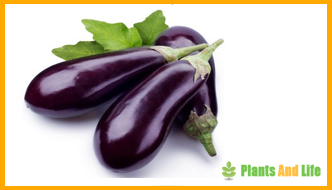
The eggplant (Solanum melongena L.) is a species of dicots in the Solanaceae family, native to Asia. They are annual herbaceous plants, widely cultivated for their edible fruits as vegetable or vegetable crops. The species has been domesticated in Asia since prehistoric times. The term also refers to the fruit.
It constitutes alongside African eggplants: S. aethiopicum L., bitter eggplant, or gilo, and S. macrocarpon L., or gboma, the three cultivated eggplant species. Unlike potatoes and tomatoes, these Old World Solanaceae follow their own globalization journey.
Denomination
De Candolle originates from the modern French term Sanskrit vaatingan, which has become Baadangan in Hindustani, Bâdenǧân (بادنجان) in Persian, Patlıcan in Turkish, Bedengiam, Baadanjaan, Al-Bādinjân in Arabic (Berenjena in Spanish) , albergínia in Catalan, eggplant in French. The Portuguese beringela is said to have been adopted in India in the brinjal form, which is found in the French beringed, brindle (used in Reunion and Mauritius), and bream in Cajun French.
The eggplant is also called melongene (or melongin). Avicenna is the first to name it melongena, which Linnea retains with the binomial name Solanum melongena. The Latin name mala insana ("unhealthy fruit") attributed to the fifteenth century by Hermolao Barbaro, was used by botanists. He gave Italian melanzana and modern Greek melitzána (μελιτζάνα).
R. Arveiller published on this subject in 1969 an important philological study entitled The French names of the eggplant.
The name egg plant, in use in English (United States) eggplant, originally from the German Eierfrucht, dates from the time of the British occupation of India. The largest number of names for eggplant is in Sanskrit: 41, followed by Tamil: 17
Siamese eggplant with variegated fruit designates Solanum ferox and Solanum virginianum according to the authors.
Description
The port of the eggplant is erect, bushy, and 50 cm to 2 m high depending on the climate.
The solitary white or purple flowers are carried in the leaf axils. The fruits are berries of a great variety of shape (ovoid, piriform, spherical, cylindrical and very elongated) and of different colors (from ivory white, yellow, green, and more generally purple, purplish until almost black) , degraded or streaked, like the superb Listada de Gandia dark purple with stripes and cream dots.
 Food and nutrition
Food and nutritionThe eggplant is eaten cooked or raw, especially in certain Asian cultures, in Japan the "water eggplants" (水 ナ ス) are made in tsukemono or salt. We keep the skin of varieties without bitterness, modern cultivars have increasingly thin and digestible skin.
The taste of cooked eggplant evokes that of mushrooms, Georges Cuvier compares it to that of oronge.
It is very low in calories (24 calories per 100 g, 2% of the RDI for 100 g), does not contain fat, and is rich in soluble fibers of which 100 g provides 10% of the RDA. It provides minerals, especially potassium, manganese, copper and selenium. It is rich in many B vitamins (B1 or thiamine, B5 or pantothenic acid, B6 or pyridoxine, B9 or folic acid). It is therefore a good candidate for the anti-obesity diet, subject to cooking it without oil, which it takes pleasure in absorbing (cooking with water, steam, in the oven in a cooking bag, dry or in juice pan-fried lime, grilled, pickled, etc.). In 2019, a Brazilian team conducted a four-month, double-blind randomized experiment on 420 obese women subjected to a hypoenergetic diet with or without the addition of eggplant flour, eggplant flour significantly increases the antioxidant effects and the reduction fat mass.
Allergy
Eggplant allergies have been documented in Indian publications. In 2008, a study on 761 subjects showed 1.4% of allergic symptoms in reaction to a skin test, predominantly female. A case was analyzed in India in 2008. In 2009, an evaluation on 6 subjects made it possible to identify 6 allergens present "in all the edible parts with a preponderance in the skin". In the same year, a search for allergenic cultivars (with a high histamine content, which is roughly the same raw or cooked) showed strong heterogeneity between cultivars, the spherical greens having the highest percentage.

